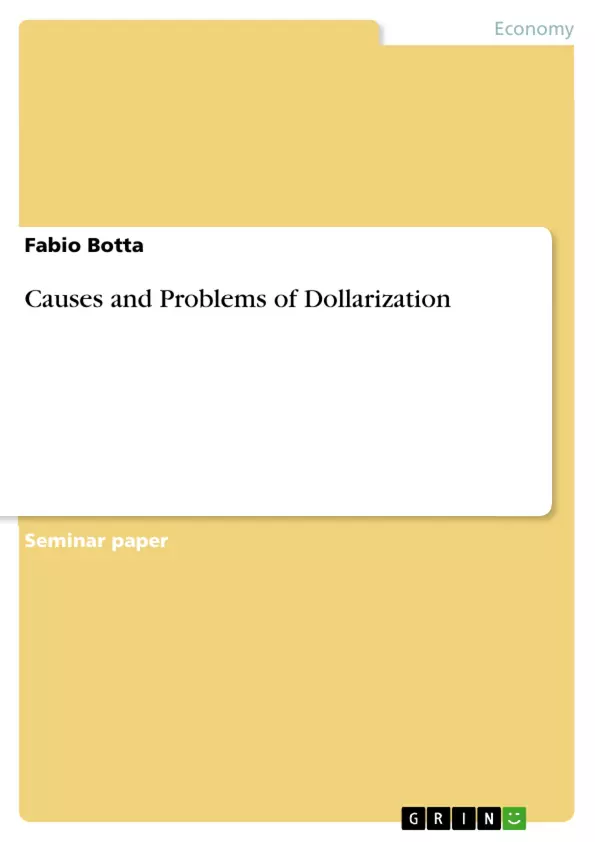This paper discusses the causes and problems associated with dollarization. Based on the results, it addresses the questions of how high dollarization rates can be evaluated and, in particular, whether it is advisable to opt for full dollarization (FD) or to what extent policymakers should rather aim for de-dollarization. As an introduction to the discussion, Chapter 2 will give a short illustration of the theoretical concepts of dollarization. Chapter 3 will then explain the causes of dollarization. The subsequent description of the advantages of FD in Chapter 4, which can also be cited as a reason for high rates of dollarization,3 leads directly to the problems associated with dollarization in Chapter 5. These problems arise – unless otherwise stated – both from high dollarization rates and from FD. The research up to Chapter 5 concentrates on a more theoretical level. The discussion on how to evaluate the causes and problems in Chapter 6 tries to link theoretical concepts with more general empirical analyses. Chapter 7 provides a brief conclusion of the most important findings and concludes with recommendations for future research.
“Dollarization has evolved as one of the noteworthy features of globalization during the last two decades.” Although Mr. Yilmaz, the then Governor of the Central Bank of the Republic of Turkey, said this sentence at a conference on dollarization in December 2006, it remains more relevant than ever. Due to the increasing integration of the international financial system, the lifting of restrictions on capital mobility and the growing volume of trade, the debate on dollarization met with a growing interest in the 1990s. Nonetheless, today's economic journals are still filled with new publications on dollarization.
Inhaltsverzeichnis (Table of Contents)
- Introduction
- Theoretical concepts and characteristics
- Causes of dollarization
- Benefits of full dollarization
- Problems associated with dollarization
- Discussion on how to evaluate the causes and problems.
- Conclusion.
Zielsetzung und Themenschwerpunkte (Objectives and Key Themes)
This paper aims to analyze the causes and problems associated with dollarization, exploring the factors contributing to high dollarization rates and examining the potential benefits and drawbacks of full dollarization. It investigates whether high dollarization rates are beneficial or detrimental to a country's economic development, and considers the implications for policymakers in terms of promoting or discouraging dollarization.
- Causes of Dollarization
- Benefits of Full Dollarization
- Problems associated with Dollarization
- Methods for Evaluating Dollarization Rates
- Policy Implications for Dollarization
Zusammenfassung der Kapitel (Chapter Summaries)
- Introduction: This chapter sets the context for the paper by discussing the growing importance of dollarization in the globalized economy. It highlights the ongoing debate surrounding dollarization and outlines the paper's objectives and structure.
- Theoretical concepts and characteristics: This chapter defines dollarization, distinguishing between informal dollarization and full dollarization. It explains the concepts of asset dollarization and liability dollarization, and explores different measurement methods used for assessing dollarization rates.
- Causes of dollarization: This chapter examines the various factors that contribute to dollarization, such as economic instability, inflation, and lack of confidence in domestic currency. It explores the role of external factors, including globalization and international financial integration, in driving dollarization.
- Benefits of full dollarization: This chapter discusses the potential advantages of adopting full dollarization, such as reduced inflation, increased price stability, and greater access to international capital markets. It considers the arguments in favor of full dollarization and explores the potential benefits for both developing and developed countries.
- Problems associated with dollarization: This chapter examines the potential drawbacks of dollarization, including loss of monetary policy independence, vulnerability to external shocks, and limitations on economic policy options. It discusses the challenges associated with both high dollarization rates and full dollarization, exploring the potential negative consequences for a country's economy.
Schlüsselwörter (Keywords)
This paper focuses on the phenomenon of dollarization, examining its causes, consequences, and policy implications. Key themes include economic instability, inflation, globalization, full dollarization, asset dollarization, liability dollarization, monetary policy independence, and vulnerability to external shocks. The paper explores various theoretical concepts and empirical analyses related to dollarization, aiming to contribute to the ongoing debate surrounding this significant economic phenomenon.
- Quote paper
- Fabio Botta (Author), 2020, Causes and Problems of Dollarization, Munich, GRIN Verlag, https://www.hausarbeiten.de/document/703214


